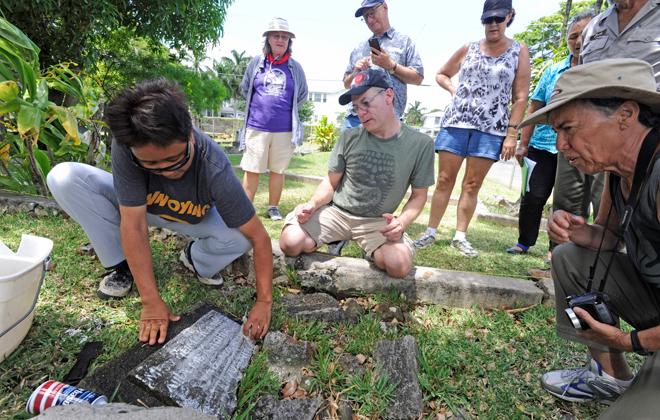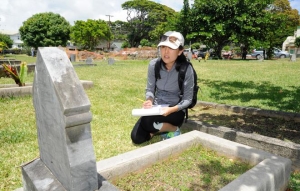Preservation in the News: This past week, UH Students and community members learned best practices for grave marker restoration and documentation from experts including Richard Miller who oversees the restoration of thousands of burial sites at Kalaupapa National Historic Park on Molokai.
*********

Bruce Asato / basato@staradvertiser.com University of Hawaii architecture student Lin Whipkey used shaving cream Thursday to make out lettering on a gravestone that was otherwise unreadable in Ma‘e¬ma‘e Chapel Cemetery in Nuu¬anu. UH students in American studies and architecture joined community members to gather and re¬cord information at the cemetery.
Of grave concern: Protecting cemeteries
A historic cemetery receives care as community members and students work to document the people buried there
Honolulu Star Advertiser, Jun 6, 2015
One half of an ancient grave marker lay in a hole at Ma‘ema‘e Chapel Cemetery in Nuuanu among a pile of rocks. The other half had been left nearby.
Both pieces were discovered Thursday during a University of Hawaii and community effort to document the condition of the half-acre cemetery and its 120 or so burial sites.
Richard Miller, who oversees the restoration of thousands of burial sites at Kalaupapa National Historic Park on Molokai, on Friday showed the UH students and community members how to seal the two pieces of the weather-worn headstone back together with masonry epoxy.
After spending two days cleaning and documenting the conditions of the grave markers and burial sites at Ma‘ema‘e, the 20 or so American-studies students and community members will do similar work cleaning and cataloging grave markers Wednesday and Thursday at Pauoa Hawaiian Cemetery in Pauoa.
Then they’ll give detailed information about the state of the burial sites at both locations to Kaumakapili Church, which has owned both properties since the 1800s.
Most of the grave markers at Ma‘ema‘e date back to the late 1800s and early 1900s and memorialize a range of ethnic groups and ages.
A few were found in the grass with no obvious graves to mark. A handful of others are in danger of falling over. Several are so beaten by time and weather that the inscriptions are difficult to read.

Bruce Asato / basato@staradvertiser.com Above, Michele Makinney, a University of Hawaii graduate, left, and community member Mickey Lasco cleaned a marble slab Thursday to read the inscription chiseled on it so information could be recorded as part of a survey of Ma‘e¬ma‘e Chapel Cemetery in Nuu¬anu. ruce Asato / basato@staradvertiser.com
Miller has seen far worse.
“A lot of cemeteries are sad to look at,” he said. “Some of the inscriptions make it clear this is a neighborhood cemetery, and even though there is damage and deterioration going on, you can tell this has been cared for over the years.”
Next week Bill Chapman, director of UH’s American studies graduate program in historic preservation, will take the group down to the state archives and state library to research the names on the grave markers that they could make out.
“We want to find out more about the particular histories of these people,” Chapman said. “We want a connection to this work.”
Stephanie Chong, a 25-year-old architecture graduate student, wants to help fill in the historical record of those who were buried at both Ma‘ema‘e and Pauoa “to help connect distant relatives to their past.”
“With my own family,” Chong said, “I’m very interested in our history.”
She worked on grave markers for 19th-century infants as well as an obelisk for a person with the first name Kalokekalamakamakihina, who was born in 1853 and died in 1904.
Unlike today, when people can pick out and pay for their own headstones or grave markers, Miller said someone else in the early 20th century wanted to honor Kalokekalamakamakihina in dramatic fashion.
Markings show that the 41⁄2-foot basalt obelisk was chiseled by hand. The base includes a stone depiction of a pipe, which represented a higher status in early Hawaiian society; a stone fish suggesting that Kalokekalamakamakihina could have been a fisherman or a Christian; and an apu cup used for drinking ceremonial awa, Miller said.
“The obelisk represented a certain status and tells you something about life at that time,” Miller said. “But the obelisk itself also shows some beautiful craftsmanship.
“Obviously, we’re honoring the person below. But we’re also honoring the person who wanted to memorialize them.”
It’ll be up to Kaumakapili Church to decide what to do with all of the information that the students and community members gather at both cemeteries.
They might never know where some of the wayward grave markers belong, such as the discarded and broken headstone that was pieced back together Friday.
Through the faded inscription, the volunteers could make out the name “Miss Emma.”
But whatever happens, at least the headstones and grave markers will be accounted for.
And Miller maintains that the work will touch the lives of the UH students and community volunteers.
“It’s powerful,” Miller said. “They’ll remember that they put their hands on a monument and they left it better.”


